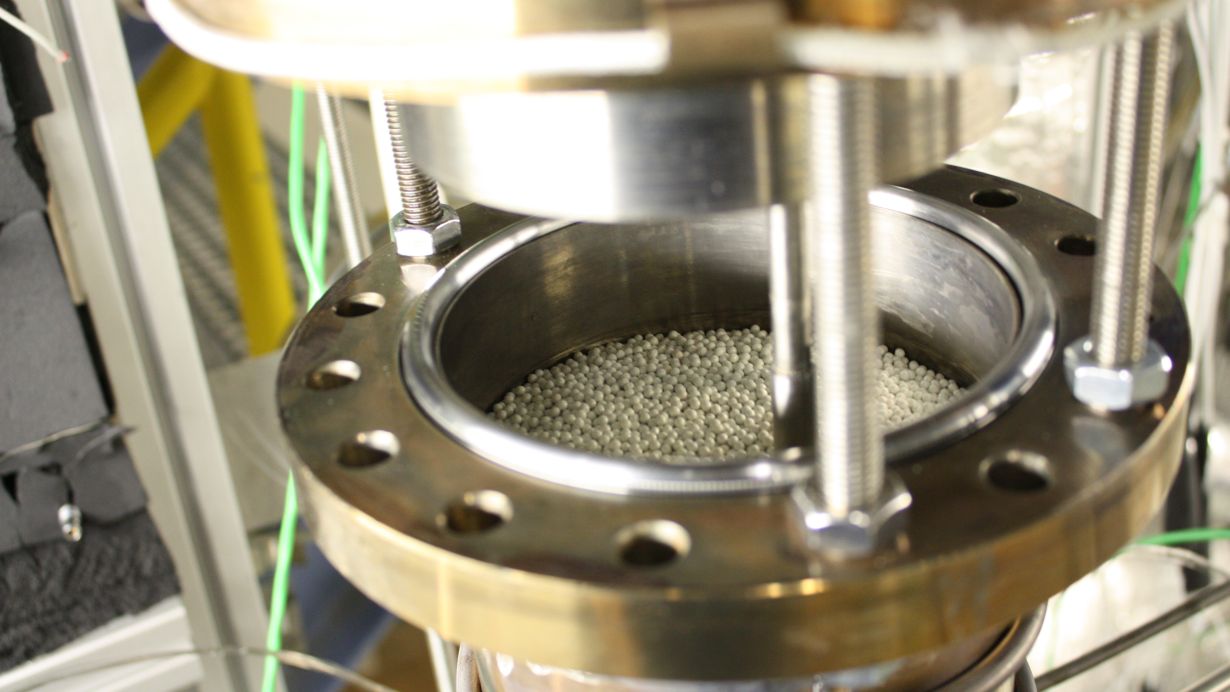The industrial production of steel, concrete, or glass requires more than 20 percent of Germany’s total energy consumption. Up to now, 90 percent of the fuels used for these processes have been of fossil nature. Researchers of Karlsruhe Institute of Technology (KIT) are working on the only high-temperature heat storage system based on liquid-metal technology of this kind in order to enhance the use of renewable energy sources. The highly conductive liquid metals can be heated to more than 700 °C using green electricity and can flexibly store industrial heat. From April 22 to 26, 2024, the researchers will present a model of their energy storage system at the KIT stand at the Energy Solutions (Hall 13, Stand C76) of the Hannover Messe.
Worldwide, high-temperature heat storage systems are being developed to supply resource-intensive production companies with heat independently of fluctuating renewable energy production. These storage systems convert electrical power into heat, which is then stored. The heat is used if needed, for instance when electricity is expensive and production processes cannot be stopped. The higher the temperature stored, the better. This reduces the amount of additional energy that would be needed to reach the desired production temperature.
Pilot plants are using liquid salts to store temperatures of around 550 °C. Even higher temperatures have been achieved with gases so far. When electrically heated to around 700 °C, they transfer their heat to storage materials such as steel, volcanic rock or slag. “However, the heat transfer from the hot gas to the storage material is far from being efficient,” says Dr. Klarissa Niedermeier from KIT’s Institute for Thermal Energy Technology and Safety.
Excellent Heat Transfer Through Liquid Metals
Together with her team, she is working on a novel solution for the high-temperature range: A heat storage system based on lead-bismuth. “The thermal conductivity of this mix of liquid metals is 100 times higher than that of other materials used in storage systems,” Niedermeier says. The high-temperature heat storage system is being tested in a loop. In a steel tank, the heated lead-bismuth seeps through ceramic beads of about 2 mm in size, releases its heat to them. When the heat is needed again, the “cold” liquid metal is returned through the beads and heats up again.
Simulations at KIT’s liquid-metal laboratory KALLA have confirmed that the use of liquid metal increases the efficiency of heat storage, especially when a very compact package is used.
Efficient Storage of Excess Green Power
“When the liquid metal is heated with power from renewable energy sources, companies have an efficient solution to mitigate fluctuations of power supply and to enable simple, inexpensive, and rapid energy storage at temperatures that are as close as possible to those used in industrial processes,” Niedermeier points out. The process has a great potential to defossilize industry. Industrial processes in Germany consume 400 terawatt hours of heat per year. 90 percent of the fuels used in these processes are fossil.
So far, liquid metals have hardly been used in heat storage systems. According to Niedermeier, this is mainly due to logistical reasons. There are only a few closed-loop systems in the world, in which such a heat storage system can be tested. KALLA has a large lead-bismuth cycle, which is used for new projects in the field of renewable energy sources, among others.
System To Be Presented at Hannover Messe 2024
At this year’s Hannover Messe, the team will present a model of the heat storage system, its size being about half that of the real system at KIT. The system at KIT is designed to store 100 kilowatt-hours of heat and has been tested on the laboratory scale at temperatures of up to 400 °C so far. “This is the world’s liquid-metal heat storage system of this kind with such a capacity. We want to show that the principle works and that it has great potential,” says Klarissa Niedermeier.
For more information, click on “Energy Storage: Hope in Hot Temperatures” on the homepage of KIT
Further information on the KArlsruhe Liquid Metal LAboratory (KALLA)
In close partnership with society, KIT develops solutions for urgent challenges – from climate change, energy transition and sustainable use of natural resources to artificial intelligence, sovereignty and an aging population. As The University in the Helmholtz Association, KIT unites scientific excellence from insight to application-driven research under one roof – and is thus in a unique position to drive this transformation. As a University of Excellence, KIT offers its more than 10,000 employees and 22,800 students outstanding opportunities to shape a sustainable and resilient future. KIT – Science for Impact.

